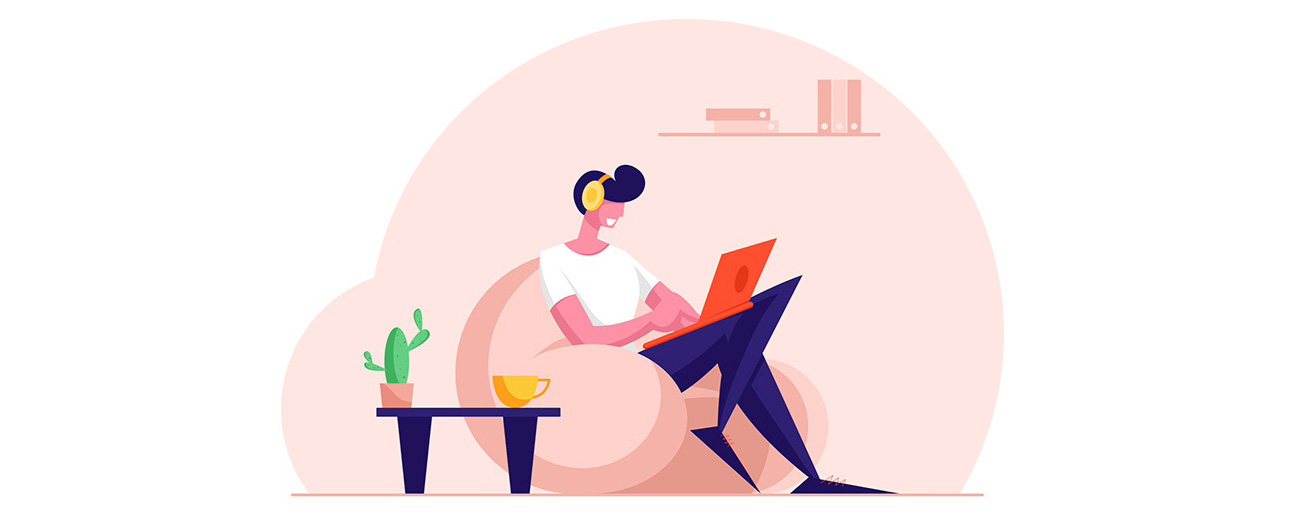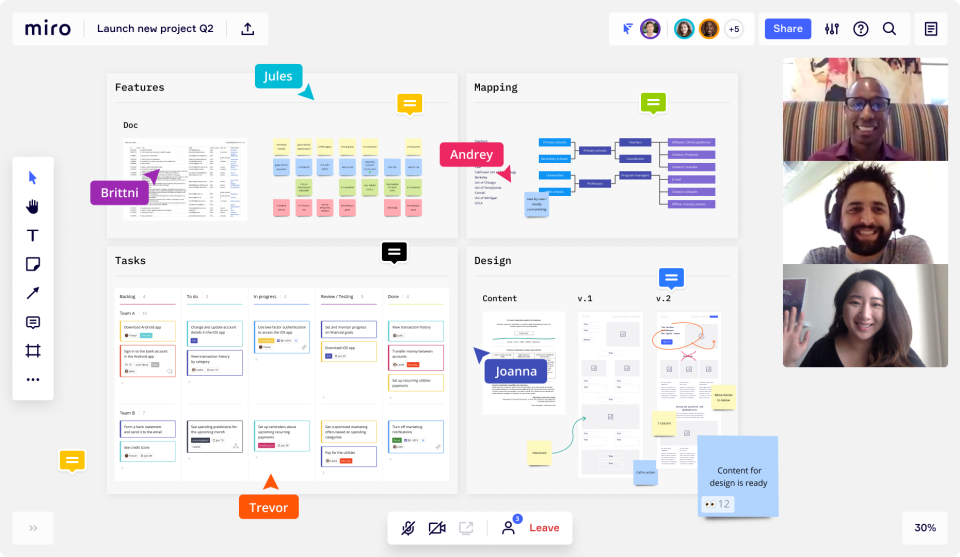Today we are living within a very historic moment. Elements of remote work that may have been only a small part of our business have become our everyday working reality. Even once we return to working in-person, the patterns we are setting today will transform the way we work moving forward. Now more than ever, we’ll need creativity and collaboration to succeed.
Right before the pandemic hit us (late 2019) our team was going through a very large merger, and we really started to shift gears on how we would use all our working tools to enable our ongoing mission to drive digitalization of the core product and design at scale. We now have more than 20 engagements running this way globally. In this post I am sharing some of the insights on collaboration and problem-solving in a remote context.
Also addressed are the differences between an operational and creation mindset–and how both are necessary for a successful business. We also shared three collaboration methods often used in-person, which you can use remotely to good effect with commonly available online tools:
One
‘Mental Excursion’ Help on keeping a remote team engaged.
Two
‘Tools and Support” Models to help you frame your sessions.
Three
‘Traditional vs. the Now” Empathy within planning and preparation.
In addition, we talked about how critical it is to establish a climate for your team that supports their creative performance even at a time of physical isolation. This is one in which everyone understands and supports the task they’re all after, everyone has each other’s back, and all believe they can find a solution.

How to:
Instill a creative mindset and culture while working remotely?
Both for you and your peers.
Creativity is something we’re all born with. In fact, we are all born creative geniuses, but at a certain moment in our lives, we learn that being creative can bring unwanted consequences. This happens specifically within our educational systems where we are taught there’s only one answer to every exam question.
As a result, learning to be creative is rather an unlearning process more than anything else. Often when we feel people are not being creative around us during a session, it’s actually our fault, not theirs. People may feel worried that they are being tested to come up with the right answer, rather than feel free to be creative. As a member of the team, it’s your job to ensure all feel safe to explore in this context. Working remotely is of absolutely no consequence to your team’s creative potential, but you will need to adapt your process to the circumstances. These steps can help you get there:
One:
Start by Assessing Morale and Emotions
Two:
Promote Psychological Safety
Make it okay for your team members to express how they feel. Even if we seem to look and act okay that doesn’t mean that we are not struggling deep inside.
It’s okay for people to feel anxious, sad, lost, afraid of uncertainty, worried about losing their jobs, or a loved one. The list goes on and on. In the past few months, I’ve noticed something very common: people are grieving on a micro and a macro level.
—
Feeling safe is vital to feeling included and build strong interpersonal relationships. Where team members feel included, safe to share their ideas, safe to experiment, and safe to challenge groupthink — is now more necessary than ever.
You need everyone’s contributions to rethink and redesign how your team works together in a forced remote or hybrid or full-time remote environments.
—
”Transparency is “job one” for leaders, Transparency is a great antidote to help people cope with fear.
How do:
Traditional design methodologies translate within fully digital landscapes.
So, what changes form a traditional/normal experience for a design team? Let’s assume that ‘traditional’ here means a team working together in a joint location/room, engaging in regular collaboration and crit sessions, directly sharing work, and (hopefully) frequently engaging with their users in the process of designing something and making it real.
With that definition, the main change now is in leadership. For the team leader and the product manager, how you curate tools and direct the group to capture insights will have a big impact on the ease and speed of this work. This will require more planning and preparation to make it go smoothly. You can’t control a global crisis per say, but you can help your team regain control of how they respond.
One:
Reset your expectations
Two:
Start with a team retrospective
Most teams are used to work synchronously, with clear rules, the same work schedule, and sharing a physical space. Your team must reset rules of engagement and collaboration. Provide more flexibility; encourage your people to focus on the outcomes instead of how and when they work developing a deeper asynchronous environment.
—
Review collectively how the team was performing before the crisis. What was working? What wasn’t working? Identify time-wasters and time-enhancers. Get rid of the first, embrace the latter. Feeling safe is vital to feeling included in a physical space, it’s quite easy to move, re-sort, build understanding, and share to a group using just post-its and markers. In the digital world, different tools fulfill different needs.
—

Three:
Reflect on remote work best practices
Identify what’s working and what’s not working. Some team members are more remote savvy than others, either because they were partially remote or did so at a previous job; leverage their expertise. Use these two questions as an example to explore and uncover insights that will help design your remote experience.
—
-
What has enabled effective remote work?
-
What has hindered remote collaboration and productivity?
Here is one example to look at: Take Microsoft Excel as a scenario case – It is a great for capturing but doesn’t help groups ‘see and feel’ emerging or growing knowledge around a product space. That’s where digital canvas tools like Miro or Mural can bridge the gap. Teams can decide when to literally zoom out together to see the big picture of affinity groups, and when to dive into the details.
How to:
Design the remote team culture.
As most organizations are going remote/hybrid, trust issues are surfacing. Productivity is suffering, people are overwhelmed, and most teams have lost their rhythm.
Few organizations were prepared to embrace asynchronous work. Remote work requires more trust, freedom, and flexibility than usual. Organizations cannot expect people to work the same way but via virtually; teams must define norms for how they’re going to meet and interact.
How can you keep your culture strong when everyone is working from home? Here are some key insights to keep your team or company alive while physically distancing.
One:
The downside of technology
Two:
Stick to your teams’ core values
Tools overcome physical distance but can hinder relationships, too. Technology accelerates both the good and bad behaviors of your culture. Trust issues and misunderstandings can quickly become bigger problems.
For example, “Whenever we read a sentence on Slack or your teams chat service that seems ambiguous or sarcastic to us, we default to thinking, You f@ker! But if someone had said the same thing to your face, you might be laughing with them.”
—
What does your company culture stand for, really? In times of crisis, your core values are put to the test. How your organization behaves now will have a long-term impact on how people perceive its culture. Leverage existing relationships; build on past successes. How did the team overcome other challenges? What approaches and learnings can be applied here now?
—
Click Here to check out Atlassian: Best virtual team building activities
Three:
It’s okay to adjust your rules
Four:
Team rituals are powerful to keep the culture alive
How can you design norms that balance freedom and accountability? Review your current rules, which one are hindering collaboration in a remote environment? Get rid of those ASAP. As a leader, will you do the right thing? Will you stick to your long-term values or choose the most convenient short-term path?
—
Technology has evolved wonderfully during the last decades. The quality of audio and video communication improves with every blink of our eyes. New ways of remote collaboration have emerged, whether they are over “traditional” formats for documentation or via digital canvas sharing or playing daily trivia; it helps bring everyone together and have some fun, too.
The reality is that there’s a tool for mostly every task and for every team. We have found that when engaging people to participate, it ultimately boils down to ensuring they can contribute and that their contribution is valued. Of course, they will also want their effort to be meaningful, so showing you’re doing something with the content of the session is also crucial.
—
How to define :
What tools and resources are there to support remote working and designing?
To be effective, design teams need tools to support two broad activities: (1) working together and (2) designing and delivering great experiences customers love. Most companies are struggling not because they don’t have enough tools, but because they have too many. People are confused about which communication channels or production tools to use.
One:
Set expectations on communication methods
This also impacts those on the fence or resistant with digital tools or remote work in general. Perhaps they were frustrated finding necessary information or have felt embarrassed by their inexperience.
Re-engaging them can take both empathy and patience. I’m a fan of one-to-one conversations in situations like this. I try to remember my own learning curve and frustrations with the tools (ask my colleagues how I feel about XYZ). You may find that the resistant person is aware that these new ways of work are needed, and that sharing their experience with someone is enough to tip the balance towards engagement.
—
- For working together, we need video communication to let us see each other and share in real time. Collaboration and documentation tools provide us the ability to communicate asynchronously and structure our knowledge. In addition, program and project management software help us know where to focus next.
- When designing and delivering great experiences, we need remote design research and user validation to enable us to know and interact with our users. We need digital canvas tools to give teams a place to think visually and explore ideas, as well as collaborative design and delivery platforms to make things real.
There are many tools to address these needs. The sooner you define the remote collaboration tools and processes that will work best for your environment and cross functional partners the sooner there will be clear results within your day to day.

Two:
Communicate – Communicate – Communicate
Three:
Listen and observe
Just remember people will have a lot of questions.
You won’t have all the answers, and that’s okay.
Be sure to show compassion – ask how people are feeling — have 1-on-1s and group check-ins. Be patient and supportive as the team adapts.
—
You want to make sure your workplace culture is alive and well when people can’t work together face-to-face. Setting up your employees for success requires more than providing the right tech tools.
When having an important transformation, one of the most often overlooked skills is to listen. Managers tend to talk much more than they pay attention to. Listen to what your team says and observe body language. Gauge morale, address cultural tensions, redesign your remote culture, and help your team navigate the forming phase. What positive behaviors do you observe? Which ones are negatively affecting productivity?
—
Ask for feedback. Listen and focus on adjusting your behavior to help the team adapt to the new “normal”. Maintaining your culture alive during a crisis will prepare your team for success once things go back to the new normal (whatever that is).
Thank you!
If you enjoyed this article then so will your friends, why not share it and all the rest of my articles be greedy it counts!



